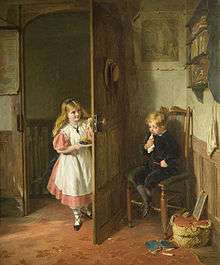Cranbrook Colony
The Cranbrook Colony was a group of artists who settled in Cranbrook, Kent from 1853 onwards[1] and were inspired by seventeenth-century Dutch and Flemish painters. They have been referred to as 'genre' painters as they tended to paint scenes of the everyday life that they saw around them in the rural area of Kent where they lived, typically scenes of domestic life; cooking and washing, children playing and other family activities.[2]

The group started with the painter Frederick Daniel Hardy who liked the countryside around Cranbrook and settled there in 1853[1]. He was joined there after four years by his mentor, Thomas Webster, their studio being an old house in the High Street, of which Hardy occupied the ground floor.
The group evolved in a rather loose and informal manner. Other artists who soon joined Hardy and Webster were Frederick Hardy's brother George Hardy, John Callcott Horsley, and George Bernard O'Neill (who married Horsley’s cousin Emma Callcott), with George Henry Boughton and Augustus Mulready frequently visiting.[3] The artists and their families formed strong bonds and were active in their local community, playing a philanthropic role in Cranbrook
Their works were mainly romanticized views of the countryside and sentimental images of bucolic simplicity which proved extremely saleable to the industrialists of the Midlands.
"The Cranbrook style was enormously popular, and had many imitators," including William Henry Knight; its artists continued a tradition "of small old-masterish pictures until the end of the century."[4]
References
- Hardy, Kimber G. (2016). The Hardy Family of Artists: Frederick Daniel, George, Heywood, James and their descendants. Woodbridge, Suffolk UK: ACC Art Books Ltd. ISBN 978 185149 826 0.
- Wolverhampton Art Gallery (2010). The Cranbrook Colony Fresh Perspectives. Wolverhampton Art Gallery. ISBN 978-0-947642-28-0.
- Cornucopia Archived 2015-09-23 at the Wayback Machine
- Christopher Wood, Victorian Painting, Boston, Little, Brown & Co., 1999; p. 313.